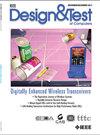A look at our industry's challenges
引用次数: 0
Abstract
h OUR INDUSTRY FACES a complex myriad of potential problems and challenges across all mediums involving design and test, and the resulting solutions and research methods used to counter experience problems are even more varied and comprehensive. Thus, it makes sense for us at some point to introduce a variety of some of the most current and striking areas of contemporary research and experimentation to our readers. While a narrower focus on selected themes is certainly a top priority for us, the reality is that our industry is varied in the truest sense of the word, and the occasional wide-issue can serve immense benefits in representing this point. This is what we have compiled in this issue; a compendium of recent, highly relevant selections that runs the gamut of problems and solutions in design and test, not only from an interindustry standpoint ranging from Trojans to 3D integration, but also from an international perspective that accounts for studies carried out across the globe. We have provided articles that should give our readers a highly interesting, yet widely informative, background on some of the most prevalent issues facing our global industry today. Indeed, our current market is filled with an ever-increasing need to go faster while maintaining fluid and efficient design; and this is a pursuit that must be highlighted on a cross-industry, global scope, if we are to fully take part in the increasing depth of international communication and collaboration. To start things off, we follow up from our last issue’s focus by providing an examination of Trojan threats due to design vulnerability with ‘‘Protection Against Hardware Trojan Attacks: Towards a Comprehensive Solution.’’ A reliance on third-party hardware IP is also highlighted as a cause for concern. A protection solution is proposed to combine predeployment design with postdeployment monitoringVa comprehensive method with high hopes for future defense. Our second entry, ‘‘Exploiting Multiple Mahalanobis Distance Metric to Screen Outliers From Analogue Product Manufacturing Test Responses,’’ provides an in-depth explanation from the University of Twente, The Netherlands, of two problemswith the Mahalanobis Distance classification method, before suggesting a new, more effective method of Multiple Mahalanobis. The conclusions are exemplified by the study of a real-world automobile product. A collaboration from New York University researchers is our third entry called ‘‘ExpeditedCompact Architecture for Average Scan Power Reduction,’’ and proposes an architectural solution to strengthen the reliability of chip under test. This selection poses to minimize scan power hot spots and high heat, while upholding design flow and delivering savings in test power. From here, we travel to researchers from the University of Ferhat Abbes in Algeria for our fourth entry, who present ‘‘An Optical BILBO for On-Line Testing of Embedded Systems,’’ an online optical testing approach to detect immediate faults in embedded systems without affecting normal operation. Using Built-In-Self-Test to combine duplication and comparison in real-time checking is examined, with the goal of stimulating further research on the benefits of optical testing. Our fifth entry, ‘‘Automatic Calibration of Streaming Applications for Software Mapping Exploration,’’ proposes a tool flow that can efficiently map streaming applications onto an MPSoC virtual platform,看看我们行业面临的挑战
我们的行业在涉及设计和测试的所有媒介中都面临着无数复杂的潜在问题和挑战,而用于应对经验问题的解决方案和研究方法则更加多样化和全面。因此,在某种程度上,我们有必要向读者介绍一些当代研究和实验的最新和最引人注目的领域。虽然专注于特定主题是我们的首要任务,但现实情况是,我们的行业在最真实的意义上是多样化的,偶尔的广泛问题可以为代表这一点提供巨大的好处。这是我们在本期中整理的内容;这是一份最新的、高度相关的选择汇编,涵盖了设计和测试中的各种问题和解决方案,不仅从跨行业的角度来看,从特洛伊木马到3D集成,而且从全球范围内进行的研究的国际视角来看。我们所提供的文章将为我们的读者提供一个非常有趣的,但广泛的信息,关于当今全球行业面临的一些最普遍的问题的背景。事实上,我们当前的市场充满了不断增长的需求,即在保持流畅和高效设计的同时更快;如果我们要充分参与日益深入的国际交流与合作,就必须在跨行业、全球范围内强调这一点。首先,我们将继续上一期的重点内容,通过“防止硬件木马攻击:迈向全面解决方案”来检查由于设计漏洞造成的木马威胁。对第三方硬件IP的依赖也是一个值得关注的问题。提出了一种将部署前设计与部署后监测相结合的防护方案,是一种对未来防御寄予厚望的综合防护方法。我们的第二个条目“利用多重马氏距离度量来筛选模拟产品制造测试响应中的异常值”,在提出一种新的、更有效的多重马氏距离分类方法之前,荷兰特温特大学对马氏距离分类方法的两个问题进行了深入的解释。最后以实际汽车产品为例,对所得结论进行了验证。来自纽约大学研究人员的合作是我们的第三个项目,名为“降低平均扫描功耗的加速紧凑架构”,并提出了一种架构解决方案,以加强被测芯片的可靠性。这种选择可以最大限度地减少扫描功率热点和高热,同时保持设计流程并节省测试功率。从这里开始,我们前往阿尔及利亚Ferhat Abbes大学的研究人员,他们提出了“嵌入式系统在线测试的光学BILBO”,这是一种在线光学测试方法,可以在不影响正常运行的情况下检测嵌入式系统中的即时故障。研究了在实时检测中使用内置自检将复制和比较相结合的方法,目的是促进对光学检测益处的进一步研究。我们的第五个条目“用于软件映射探索的流应用程序的自动校准”提出了一个工具流程,可以有效地将流应用程序映射到MPSoC虚拟平台上。
本文章由计算机程序翻译,如有差异,请以英文原文为准。
求助全文
约1分钟内获得全文
求助全文

 求助内容:
求助内容: 应助结果提醒方式:
应助结果提醒方式:


